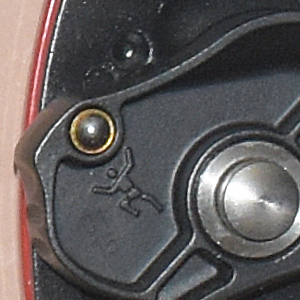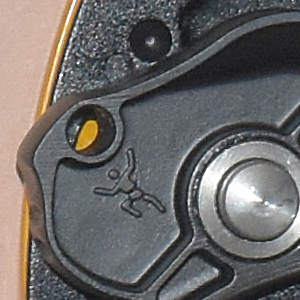The is one of the following closely-related devices:
The Slovenian company Anthron made the Anthron Lory, Bornack Lory, Edelrid Eddy, Rollgliss R250, and Singing Rock Sir. The German firm Skylotec bought Anthron in 2016 and continued production with the Skylotec Lory and Lory Pro.
Some of these were sold as belay devices, and the others as descenders. The belay device and descender versions are not the same. The difference is subtle, and easily overlooked. The belay versions have a double-ended plunger pressed into the cam. The cam can be aligned so that spring-loaded balls rest in detents in the body and cover plates, lightly holding the cam in a position that allows relatively free motion of a slack rope.
| Belay Cam |
Descender Cam |
 |
 |
One would think that any of these could be used for either purpose, but Skylotec warns against this. They certified their Lory and Lory Pro to different standards. The lawyers have spoken, and I will not openly disagree (in the U.S.A., it is unwise to disagree with lawyers). Having tried both, I can say that the belay cam seems only slightly easier to use when belaying. With either cam, I could feed rope out easily by manually lifting the cam with an index finger. Taking rope in was even easier - I just pulled it through the device. I didn't notice any difference between the two cams when rappelling: rope tension easily overpowers the spring-loaded balls.
The has excellent workmanship and it functions well. It
is solid, but it is also quite heavy. This should not be a problem
for gym climbers or people who drive to the base of short sport
climbs, but I wouldn't consider lugging one of these to a remote climb
or up a wall.
The lever function provides partial backup for the user not knowing how to use the lever, but like all such devices, it relies on the user being completely incompetent rather than partially incompetent.
The lever action has a bizarre feature: once the user
moves the lever past the release point, the lever function reverses.
In other words, I would normally lower by pulling down
on the lever, with farther down meaning a faster lower. If I pull
too far, then the cam locks. At this point, I could resume lowering
by pushing the lever up, with farther up meaning a faster lower.
If I go to far again, the action reverses a second time, and the
lever operates as it originally did. I do not like this behavior. I found that if I somehow pull the handle into the lower lock position, I could "slam" the handle upward to the upper locking position with a negligible drop, bypassing the reverse-acting behavior. Sort this out at home, not
at the cliffs. I give this feature a lemon award:  .
.
The lever assembly is greased. This grease will pick up sand
and dirt. As an enclosed device, the is not well-suited for use on severely mud-covered ropes.
![]() .
.